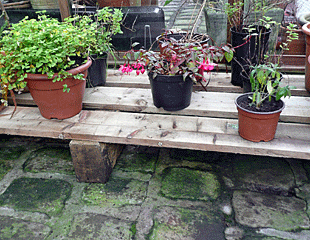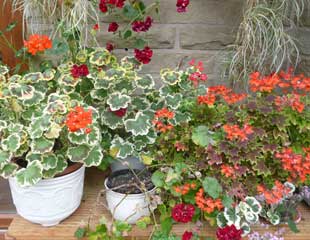How To Overwinter plants
You can overwinter tender plants in a greenhouse, lean-to, conservatory or windowsill. Wherever you place your plants for the winter, there are two main pitfalls to watch out for.
Over-watering is a common mistake; plants need to be kept dry. Plants need only a little water when dormant, water sparingly, as too much water will be fatal.
Low light levels are the other problem; do not be tempted to overwinter in a shed or garage, as the lack of light will mean the plant cannot thrive.
A sunny spot is best.
Why bother to Overwinter plants ?

Overwintering plants is a good way of keeping tender, and less hardy plants, from year to year, thus saving money. Which plants you can overwinter depends really on your available frost-free space.
I have overwintered plants in greenhouses, conservatories and a lean-to. The measure of success is not so much the place in which you overwinter, but how and the conditions.
It is difficult to get good light in winter, so to make the best of what we have, it is best to overwinter in a sunny spot. I have had more success with a lean to next to a sunny wall, than with a greenhouse, which is a bit winter-shady.
What does Grey Mould, Botrytis, look like?
If you are overwintering plants under glass, the main problem is likely to be botrytis, grey mould, particularly in a greenhouse. Winter plants need good air circulation to prevent mould. During cold spells, it is tempting to wrap up the plants and block off all the draughts, but this will create just the still, damp conditions mould enjoys.
To reduce the risk of mould, space plants well apart, avoid their leaves touching and prune if necessary. Water sparingly, open vents and doors as much as possible, and raise plants off the ground on a trestle.
At the first signs of mould, which forms on leaves as grey fuzzy powder that collapses to the touch, remove the plant and any leaves to stop it spreading. The images below show what to look for. Grey mould is a fuzzy substance on the leaves. Cut back to try and salvage the plant.
Unfortunately, the damper and wetter the winter, the harder it is to overwinter, but it is always, in my experience, worth a try as some plants will make it through.


Video How to Overwinter Tender Plants
Video Tips How to overwinter plants
A short 5 min video about how to overwinter plants. A step-by-step guide on how to prepare your plants for overwintering, how to cut them back and top tips on how to nurse your tender plants through the winter.
This will save you money by having a garden-ready plant for your garden in the spring of the next year.
Overwintering in a conservatory

All tender plants, lifted from summer bedding such as Fuchsias, Pelargoniums (also known as Geraniums) need winter protection. The approach to this depends on the aspect of your garden. If you are further north in the country, or have an exposed garden, the more tender plants are best in an unheated conservatory where they may continue flowering. Conservatories, even when unheated, are warmer than a greenhouse, and less damp, which helps to avoid grey mould, which is the problem when overwintering in the greenhouse.
Later in the season, say November, you can if you wish, cut back the plants by about a half or more. It is essential over winter to reduce watering, so it is just sparing. Personally, I let the Pelargoniums carry on flowering in the conservatory, such a cheering sight in the winter gloom, and I only cut back if they get leggy. In the spring, increase watering and start feeding.
Overwintering in a Greenhouse
Overwintering in the greenhouse is colder, although you can nurse tender plants through a winter if they need to be frost free, so it depends on the minimum temperature in your greenhouse, ideally not below 5C. Another factor is the damp and mildew. To try and reduce this, it is a good idea to raise plants off the ground, see image.
Doing this reduces the impact of the cold ground and helps to increase ventilation, which is vital to the plant's survival over the winter months. If overwintering in the greenhouse, it is better to cut the plants back to 10 cm and water very sparingly.
Overwintering in a Porch or Windowsill
You can also overwinter plants in a bright porch, or on window sill. It is much more difficult in a garage because of the low light levels, although a garage may be suitable for storing Dahlia tubers.
Plants on an inside windowsill, because it is warmer, will often carry on growing and so require more watering and regular turning because the light comes from only one side. If the plant is not turned, it will grow unevenly towards the light. In a porch, it is likely to be cooler so water less and you may need a fleece in prolonged cold spells.
Some plants can be over wintered in the ground, especially if you are in a sheltered area, such as Dahlia, Salvia, Agapanthus more so if the ground is well drained and a thick mulch is essential. Some borderline plants will survive in a sheltered garden provided they are not subject to too much winter wet.
